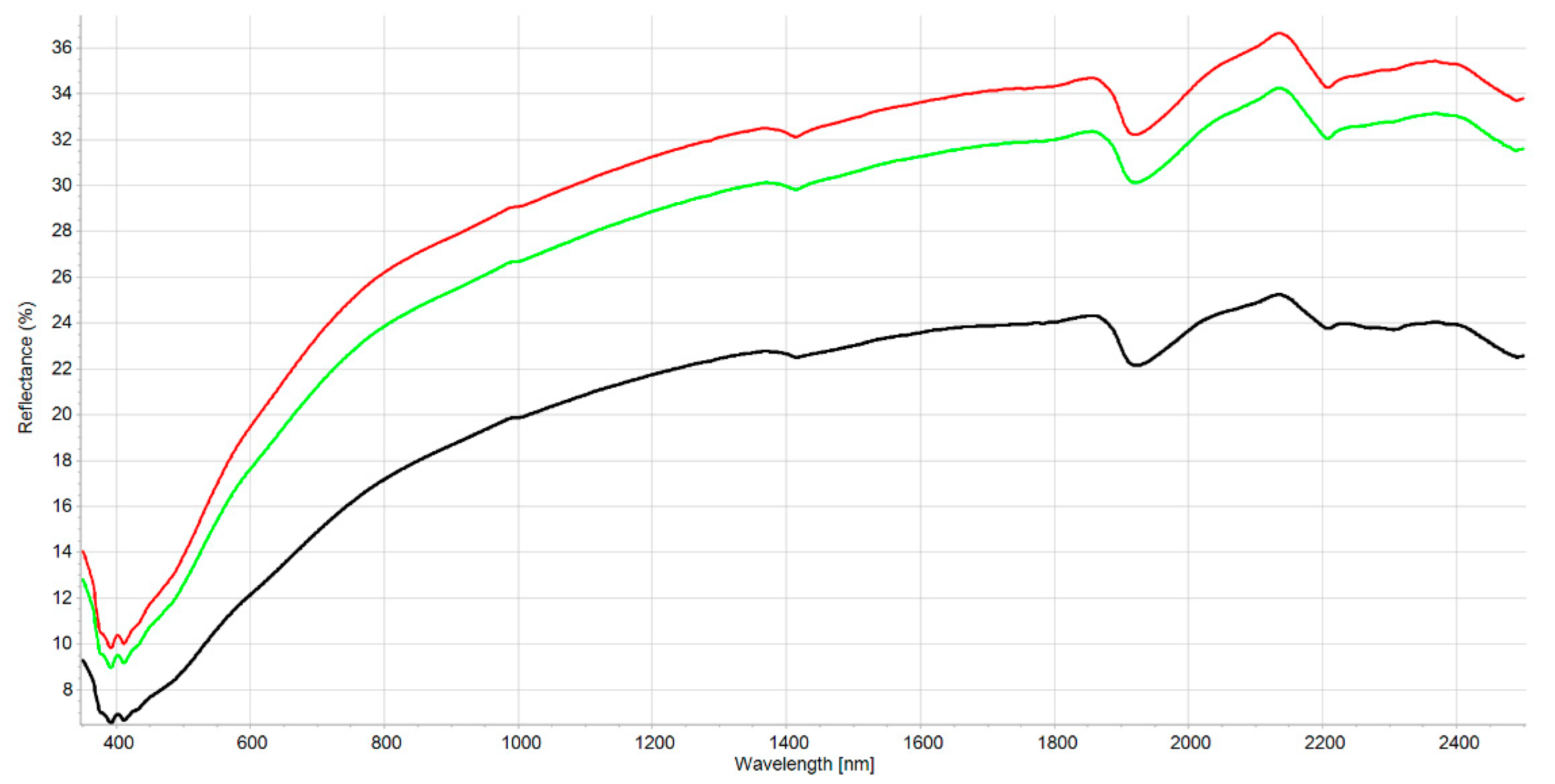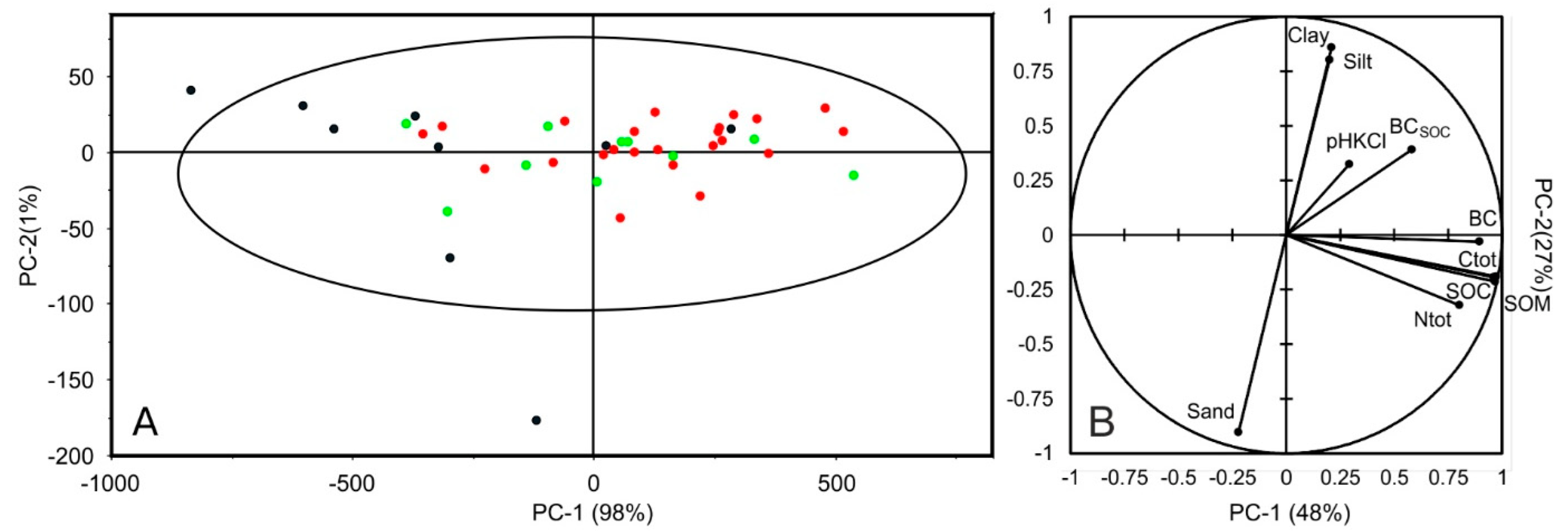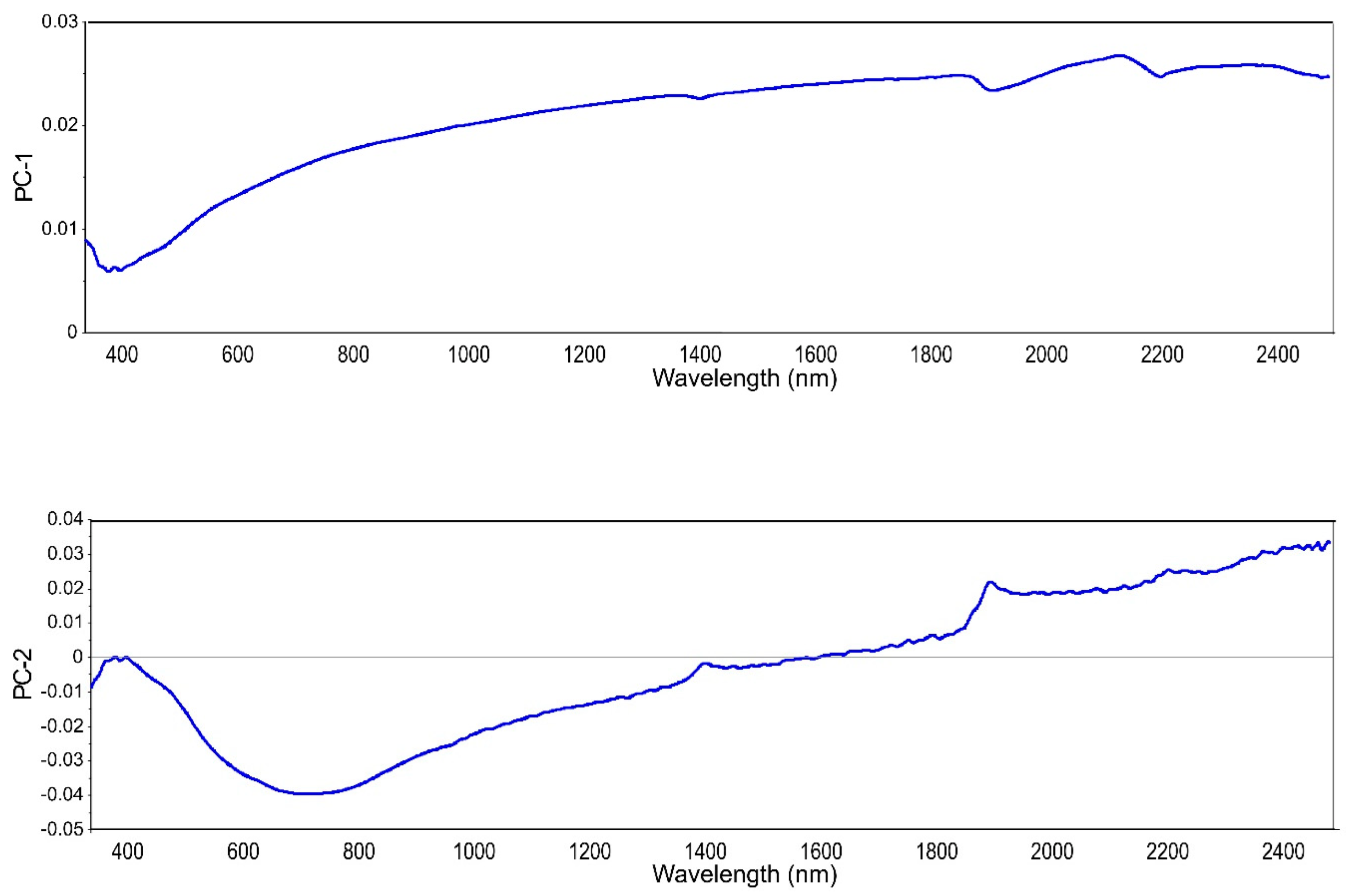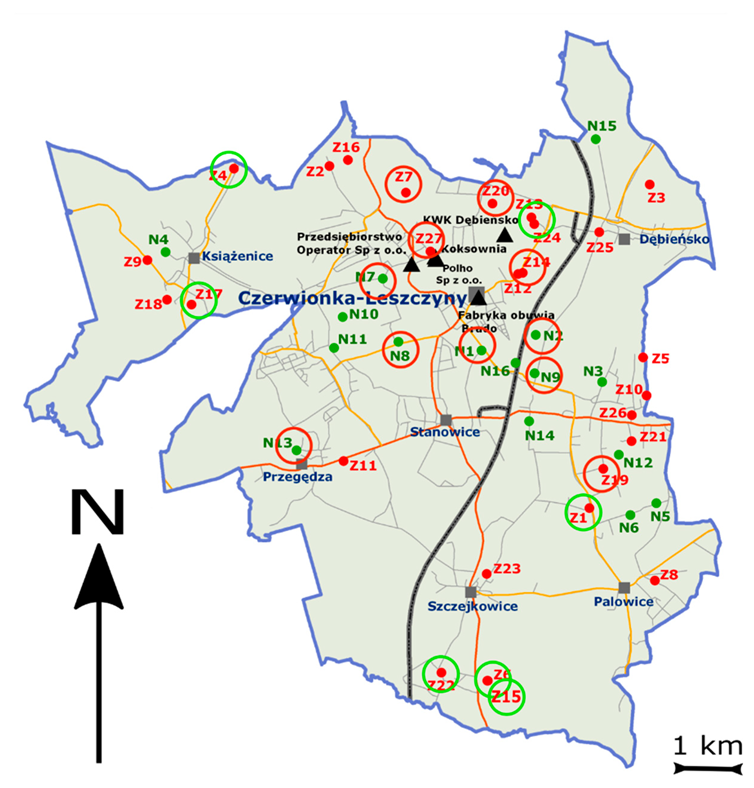Diffuse Reflectance Spectroscopy for Black Carbon Screening of Agricultural Soils under Industrial Anthropopressure
Abstract
:1. Introduction
2. Results and Discussion
2.1. Soil physical and Chemical Properties
2.2. Spectra Description
2.3. PCA Analyses
2.4. Prediction of Soil Properties
2.5. Prediction of BC Content and Attempt to Use the VIS-NIR Spectra for Screening Purposes
3. Materials and Methods
3.1. Site Description and Soil Samples Collection
3.2. Determination of Soil Properties
3.3. Determination of Black Carbon
3.4. Spectroscopic Measurements
3.5. Spectra Pretreatments and Model Construction
3.6. Classification of BC Content
4. Conclusions
Supplementary Materials
Author Contributions
Funding
Institutional Review Board Statement
Informed Consent Statement
Data Availability Statement
Conflicts of Interest
Sample Availability
References
- Liang, B.; Lehmann, J.; Sohi, S.P.; Thies, J.E.; O’Neill, B.; Trujillo, L.; Gaunt, J.; Solomon, D.; Grossman, J.; Neves, E.G.; et al. Black Carbon Affects the Cycling of Non-Black Carbon in Soil. Org. Geochem. 2010, 41, 206–213. [Google Scholar] [CrossRef]
- Schmidt, M.W.I.; Noack, A.G. Black Carbon in Soils and Sediments: Analysis, Distribution, Implications, and Current Challenges. Glob. Biogeochem. Cycles 2000, 14, 777–793. [Google Scholar] [CrossRef]
- Han, Y.M.; Cao, J.J.; Lee, S.C.; Ho, K.F.; An, Z.S. Different Characteristics of Char and Soot in the Atmosphere and Their Ratio as an Indicator for Source Identification in Xi’an, China. Atmos. Chem. Phys. 2010, 10, 595–607. [Google Scholar]
- Krasilnikov, P.V. Stable Carbon Compounds in Soils: Their Origin and Functions. Eurasian Soil Sci. 2015, 48, 997–1008. [Google Scholar] [CrossRef]
- Antony, R.; Grannas, A.M.; Willoughby, A.S.; Sleighter, R.L.; Thamban, M.; Hatcher, P.G. Origin and Sources of Dissolved Organic Matter in Snow on the East Antarctic Ice Sheet. Environ. Sci. Technol. 2014, 48, 6151–6159. [Google Scholar] [CrossRef]
- Brosset, C.; Åkerström, Å. Long Distance Transport of Air Pollutants—Measurements of Black Air-Borne Particulate Matter (Soot) and Particle-Borne Sulphur in Sweden during the Period of September–December 1969. Atmos. Environ. 1972, 6, 661–673. [Google Scholar] [CrossRef]
- Gennadiev, A.N.; Pikovskii, Yu.i.; Chernyanskii, S.S.; Alekseeva, T.A.; Kovach, R.G. Forms of Polycyclic Aromatic Hydrocarbons and Factors of Their Accumulations in Soils Affected by Technogenic Pollution (Moscow Oblast). Eurasian Soil Sci. 2004, 37, 697–709. [Google Scholar]
- Kuhlbusch, T.A.J. Method for Determining Black Carbon in Residues of Vegetation Fires. Environ. Sci. Technol. 1995, 29, 2695–2702. [Google Scholar]
- Kuhlbusch, T.A.; Crutzen, P.J. Black Carbon, the Global Carbon Cycle, and Atmospheric Carbon Dioxide. In Biomass Burning and Global Change; Levine, J.S., Ed.; The MIT Press: Cambridge, MA, USA, 1996; pp. 160–169. [Google Scholar]
- Kuzyakov, Y.; Subbotina, I.; Chen, H.; Bogomolova, I.; Xu, X. Black Carbon Decomposition and Incorporation into Soil Microbial Biomass Estimated by 14C Labeling. Soil Biol. Biochem. 2009, 41, 210–219. [Google Scholar] [CrossRef]
- Forbes, M.S.; Raison, R.J.; Skjemstad, J.O. Formation, Transformation and Transport of Black Carbon (Charcoal) in Terrestrial and Aquatic Ecosystems. Sci. Total Environ. 2006, 370, 190–206. [Google Scholar] [CrossRef]
- Krull, E.S.; Swanston, C.W.; Skjemstad, J.O.; McGowan, J.A. Importance of Charcoal in Determining the Age and Chemistry of Organic Carbon in Surface Soils. J. Geophys. Res. Biogeosci. 2006, 111, G04001. [Google Scholar] [CrossRef]
- Hammes, K.; Schmidt, M.W.I.; Smernik, R.J.; Currie, L.A.; Ball, W.P.; Nguyen, T.H.; Louchouarn, P.; Houel, S.; Gustafsson, Ö.; Elmquist, M.; et al. Comparison of Quantification Methods to Measure Fire-Derived (Black/Elemental) Carbon in Soils and Sediments Using Reference Materials from Soil, Water, Sediment and the Atmosphere. Glob. Biogeochem. Cycles 2007, 21, GB3016. [Google Scholar] [CrossRef] [Green Version]
- Fuchs, G.; Boll, M.; Heider, J. Microbial Degradation of Aromatic Compounds—From One Strategy to Four. Nat. Rev. Microbiol. 2011, 9, 803–816. [Google Scholar] [CrossRef]
- Hilscher, A.; Knicker, H. Carbon and Nitrogen Degradation on Molecular Scale of Grass-Derived Pyrogenic Organic Material during 28 Months of Incubation in Soil. Soil Biol. Biochem. 2011, 43, 261–270. [Google Scholar] [CrossRef]
- Bodor, K.; Szép, R.; Bodor, Z. The Human Health Risk Assessment of Particulate Air Pollution (PM2.5 and PM10) in Romania. Toxicol. Rep. 2022, 9, 556–562. [Google Scholar] [CrossRef]
- Shrestha, G.; Traina, S.J.; Swanston, C.W. Black Carbon’s Properties and Role in the Environment: A Comprehensive Review. Sustainability 2010, 2, 294–320. [Google Scholar] [CrossRef] [Green Version]
- Koelmans, A.A.; Jonker, M.T.O.; Cornelissen, G.; Bucheli, T.D.; Van Noort, P.C.M.; Gustafsson, Ö. Black Carbon: The Reverse of Its Dark Side. Chemosphere 2006, 63, 365–377. [Google Scholar] [CrossRef]
- Ghosh, U.; Zimmerman, J.R.; Luthy, R.G. PCB and PAH Speciation among Particle Types in Contaminated Harbor Sediments and Effects on PAH Bioavailability. Environ. Sci. Technol. 2003, 37, 2209–2217. [Google Scholar] [CrossRef]
- Gustafsson, Ö.; Haghseta, F.; Chan, C.; MacFarlane, J.; Gschwend, P.M. Quantification of the Dilute Sedimentary Soot Phase: Implications for PAH Speciation and Bioavailability. Environ. Sci. Technol. 1997, 31, 203–209. [Google Scholar] [CrossRef]
- Oen, A.M.P.; Cornelissen, G.; Breedveld, G.D. Relation between PAH and Black Carbon Contents in Size Fractions of Norwegian Harbor Sediments. Environ. Pollut. 2006, 141, 370–380. [Google Scholar] [CrossRef]
- Ukalska-Jaruga, A.; Debaene, G.; Smreczak, B. Dissipation and Sorption Processes of Polycyclic Aromatic Hydrocarbons (PAHs) to Organic Matter in Soils Amended by Exogenous Rich-Carbon Material. J. Soils Sedim. 2020, 20, 836–849. [Google Scholar] [CrossRef] [Green Version]
- Agarwal, T.; Bucheli, T.D. Adaptation, Validation and Application of the Chemo-Thermal Oxidation Method to Quantify Black Carbon in Soils. Environ. Pollut. 2011, 159, 532–538. [Google Scholar] [CrossRef] [PubMed]
- Schmidt, M.W.I.; Skjemstad, J.O.; Jäger, C. Carbon Isotope Geochemistry and Nanomorphology of Soil Black Carbon: Black Chernozemic Soils in Central Europe Originate from Ancient Biomass Burning. Glob. Biogeochem. Cycles 2002, 16, 1123. [Google Scholar] [CrossRef]
- Bornemann, L.; Welp, G.; Brodowski, S.; Rodionov, A.; Amelung, W. Rapid Assessment of Black Carbon in Soil Organic Matter Using Mid-Infrared Spectroscopy. Org. Geochem. 2008, 39, 1537–1544. [Google Scholar] [CrossRef]
- Hobley, E.; Willgoose, G.R.; Frisia, S.; Jacobsen, G. Vertical Distribution of Charcoal in a Sandy Soil: Evidence from DRIFT Spectra and Field Emission Scanning Electron Microscopy. Eur. J. Soil Sci. 2014, 65, 751–762. [Google Scholar] [CrossRef]
- Bellon-Maurel, V.; McBratney, A. Near-Infrared (NIR) and Mid-Infrared (MIR) Spectroscopic Techniques for Assessing the Amount of Carbon Stock in Soils—Critical Review and Research Perspectives. Soil Biol. Biochem. 2011, 43, 1398–1410. [Google Scholar] [CrossRef]
- Debaene, G.; Niedźwiecki, J.; Pecio, A.; Żurek, A. Effect of the Number of Calibration Samples on the Prediction of Several Soil Properties at the Farm-Scale. Geoderma 2014, 214–215, 114–125. [Google Scholar] [CrossRef]
- Debaene, G.; Pikula, D.; Niedźwiecki, J. Use of VIS-NIRS for Land Management Classification with a Support Vector Machine and Prediction of Soil Organic Carbon and Other Soil Properties. Cienc. Investig. Agrar. 2014, 41, 21–32. [Google Scholar] [CrossRef] [Green Version]
- Ji, W.; Shi, Z.; Huang, J.; Li, S. In Situ Measurement of Some Soil Properties in Paddy Soil Using Visible and Near-Infrared Spectroscopy. PLoS ONE 2014, 9, e105708. [Google Scholar] [CrossRef] [Green Version]
- Klimkowicz-Pawlas, A.; Debaene, G. Screening Risk Assessment of Agricultural Areas under a High Level of Anthropopressure Based on Chemical Indexes and VIS-NIR Spectroscopy. Molecules 2020, 25, 3151. [Google Scholar] [CrossRef]
- Conforti, M.; Matteucci, G.; Buttafuoco, G. Using Laboratory Vis-NIR Spectroscopy for Monitoring Some Forest Soil Properties. J. Soils Sedim. 2018, 18, 1009–1019. [Google Scholar] [CrossRef]
- Jarquín-Sánchez, A.; García, S.S.; López, D.J.P.; Chiu, W.C. Analysis of Soil Organic Matter in Tropical Soils with Near-Infrared Spectroscopy (NIRS) and Chemometrics. Cienc. Investig. Agrar. 2012, 39, 387–394. [Google Scholar] [CrossRef] [Green Version]
- Zornoza, R.; Guerrero, C.; Mataix-Solera, J.; Scow, K.M.; Arcenegui, V.; Mataix-Beneyto, J. Near Infrared Spectroscopy for Determination of Various Physical, Chemical and Biochemical Properties in Mediterranean Soils. Soil Biol. Biochem. 2008, 40, 1923–1930. [Google Scholar] [CrossRef]
- Klimkowicz-Pawlas, A.; Smreczak, B.; Ukalska-Jaruga, A. The Impact of Selected Soil Organic Matter Fractions on the PAH Accumulation in the Agricultural Soils from Areas of Different Anthropopressure. Environ. Sci. Pollut. Res. 2017, 24, 10955–10965. [Google Scholar] [CrossRef]
- Ukalska-Jaruga, A.; Smreczak, B.; Klimkowicz-Pawlas, A. Soil Organic Matter Composition as a Factor Affecting the Accumulation of Polycyclic Aromatic Hydrocarbons. J. Soils Sedim. 2019, 19, 1890–1900. [Google Scholar] [CrossRef] [Green Version]
- Ilek, A.; Kucza, J.; Szostek, M. The Effect of the Bulk Density and the Decomposition Index of Organic Matter on the Water Storage Capacity of the Surface Layers of Forest Soils. Geoderma 2017, 285, 27–34. [Google Scholar] [CrossRef]
- Kaczyński, R.; Siebielec, G.; Gałązka, R.; Niedźwiecki, J.; Polakova, S. Assessment of Soil Organic Carbon Status and Changes in Soils of Polish–Czech Borderlands; Central Institute for Supervising and Testing in Agriculture (ÚKZÚZ), Institute for Soil Science and Plant Cultivation (IUNG): Brno, Czech Republic, 2013. [Google Scholar]
- Koſodziej, B.; Bryk, M.; Sſowiſska-Jurkiewicz, A.; Otremba, K.; Gilewska, M. Soil Physical Properties of Agriculturally Reclaimed Area after Lignite Mine: A Case Study from Central Poland. Soil Tillage Res. 2016, 163, 54–63. [Google Scholar] [CrossRef]
- Rawlins, B.G.; Vane, C.H.; Kim, A.W.; Tye, A.M.; Kemp, S.J.; Bellamy, P.H. Methods for Estimating Types of Soil Organic Carbon and Their Application to Surveys of UK Urban Areas. Soil Use Manag. 2008, 24, 47–59. [Google Scholar] [CrossRef] [Green Version]
- Edmondson, J.L.; Stott, I.; Potter, J.; Lopez-Capel, E.; Manning, D.A.C.; Gaston, K.J.; Leake, J.R. Black Carbon Contribution to Organic Carbon Stocks in Urban Soil. Environ. Sci. Technol. 2015, 49, 8339–8346. [Google Scholar] [CrossRef]
- Chen, C.; Hu, K.; Li, H.; Yun, A.; Li, B. Three-Dimensional Mapping of Soil Organic Carbon by Combining Kriging Method with Profile Depth Function. PLoS ONE 2015, 10, e0129038. [Google Scholar] [CrossRef] [Green Version]
- Masiello, C.A. New Directions in Black Carbon Organic Geochemistry. Mar. Chem. 2004, 92, 201–213. [Google Scholar] [CrossRef]
- Gao, C.; Knorr, K.-H.; Yu, Z.; He, J.; Zhang, S.; Lu, X.; Wang, G. Black Carbon Deposition and Storage in Peat Soils of the Changbai Mountain, China. Geoderma 2016, 273, 98–105. [Google Scholar] [CrossRef]
- Koschke, L.; Lorz, C.; Fürst, C.; Glaser, B.; Makeschin, F. Black Carbon in Fly-Ash Influenced Soils of the Dübener Heide Region, Central Germany. Water Air Soil Pollut. 2011, 214, 119–132. [Google Scholar] [CrossRef]
- Stenberg, B.; Viscarra Rossel, R.A.; Mouazen, A.M.; Wetterlind, J. Visible and near Infrared Spectroscopy in Soil Science. In Advances in Agronomy; Sparks, D.L., Ed.; Academic Press: Burlington, NJ, USA, 2010; Volume 107, pp. 163–215. [Google Scholar]
- Ouatmane, A.; Dorazio, V.; Hafidi, M.; Revel, J.-C.; Senesi, N. Elemental and Spectroscopic Characterization of Humic Acids Fractionated by Gel Permeation Chromatography. Agronomy 2000, 20, 491–504. [Google Scholar] [CrossRef]
- Ben-Dor, E. Quantitative Remote Sensing of Soil Properties. Adv. Agron. 2002, 75, 173–243. [Google Scholar]
- Verheyen, D.; Diels, J.; Kissi, E.; Poesen, J. The Use of Visible and Near-Infrared Reflectance Measurements for Identifying the Source of Suspended Sediment in Rivers and Comparison with Geochemical Fingerprinting. J. Soils Sedim. 2014, 14, 1869–1885. [Google Scholar] [CrossRef] [Green Version]
- Workman, J.; Weyer, L. Appendix D. Spectra−Structure Correlations for Near Infrared. In Practical Guide and Spectral Atlas for Interpretive Near-Infrared Spectroscopy; CRC Press: Boca Raton, FL, USA, 2012; pp. 229–267. [Google Scholar]
- He, T.; Wang, J.; Lin, Z.; Cheng, Y. Spectral Features of Soil Organic Matter. Geo Spat. Inf. Sci. 2009, 12, 33–40. [Google Scholar] [CrossRef] [Green Version]
- Ladoni, M.; Bahrami, H.A.; Alavipanah, S.K.; Norouzi, A.A. Estimating Soil Organic Carbon from Soil Reflectance: A Review. Precis. Agric. 2010, 11, 82–99. [Google Scholar] [CrossRef]
- Wu, C.-Y.; Jacobson, A.R.; Laba, M.; Baveye, P.C. Accounting for Surface Roughness Effects in the Near-Infrared Reflectance Sensing of Soils. Geoderma 2009, 152, 171–180. [Google Scholar] [CrossRef]
- Chartrand, R. Numerical Differentiation of Noisy, Nonsmooth Data. ISRN Appl. Math. 2011, 2011, 164564. [Google Scholar] [CrossRef] [Green Version]
- Aïchi, H.; Fouad, Y.; Walter, C.; Viscarra Rossel, R.A.; Lili Chabaane, Z.; Sanaa, M. Regional Predictions of Soil Organic Carbon Content from Spectral Reflectance Measurements. Biosyst. Eng. 2009, 104, 442–446. [Google Scholar] [CrossRef]
- Bao, N.; Wu, L.; Ye, B.; Yang, K.; Zhou, W. Assessing Soil Organic Matter of Reclaimed Soil from a Large Surface Coal Mine Using a Field Spectroradiometer in Laboratory. Geoderma 2017, 288, 47–55. [Google Scholar] [CrossRef]
- Dexter, A.R.; Richard, G.; Arrouays, D.; Czyż, E.A.; Jolivet, C.; Duval, O. Complexed Organic Matter Controls Soil Physical Properties. Geoderma 2008, 144, 620–627. [Google Scholar] [CrossRef]
- Veum, K.S.; Sudduth, K.A.; Kremer, R.J.; Kitchen, N.R. Estimating a Soil Quality Index with VNIR Reflectance Spectroscopy. Soil Sci. Soc. Am. J. 2015, 79, 637–649. [Google Scholar] [CrossRef]
- Wang, D.; Chakraborty, S.; Weindorf, D.C.; Li, B.; Sharma, A.; Paul, S.; Ali, M.N. Synthesized Use of VisNIR DRS and PXRF for Soil Characterization: Total Carbon and Total Nitrogen. Geoderma 2015, 243, 157–167. [Google Scholar] [CrossRef]
- Bartholomeus, H.M.; Schaepman, M.E.; Kooistra, L.; Stevens, A.; Hoogmoed, W.B.; Spaargaren, O.S.P. Spectral Reflectance Based Indices for Soil Organic Carbon Quantification. Geoderma 2008, 145, 28–36. [Google Scholar] [CrossRef]
- Kanning, M.; Siegmann, B.; Jarmer, T. Regionalization of Uncovered Agricultural Soils Based on Organic Carbon and Soil Texture Estimations. Remote Sens. 2016, 8, 927. [Google Scholar] [CrossRef] [Green Version]
- Knadel, M.; Thomsen, A.; Greve, M.H. Multisensor On-the-Go Mapping of Soil Organic Carbon Content. Soil Sci. Soc. Am. J. 2011, 75, 1799–1806. [Google Scholar] [CrossRef]
- Ben-Dor, E.; Heller, D.; Chudnovsky, A. A Novel Method of Classifying Soil Profiles in the Field Using Optical Means. Soil Sci. Soc. Am. J. 2008, 72, 1113–1123. [Google Scholar] [CrossRef]
- Debaene, G.; Bartmiński, P.; Niedźwiecki, J.; Miturski, T. Visible and Near-Infrared Spectroscopy as a Tool for Soil Classification and Soil Profile Description. Pol. J. Soil Sci. 2017, 50, 1. [Google Scholar] [CrossRef] [Green Version]
- Li, S.; Shi, Z.; Chen, S.; Ji, W.; Zhou, L.; Yu, W.; Webster, R. In Situ Measurements of Organic Carbon in Soil Profiles Using Vis-NIR Spectroscopy on the Qinghai–Tibet Plateau. Environ. Sci. Technol. 2015, 49, 4980–4987. [Google Scholar] [CrossRef]
- Schmidt, M.W.I.; Skjemstad, J.O.; Czimczik, C.I.; Glaser, B.; Prentice, K.M.; Gelinas, Y.; Kuhlbusch, T.A.J. Comparative Analysis of Black Carbon in Soils. Glob. Biogeochem. Cycles 2001, 15, 163–167. [Google Scholar] [CrossRef] [Green Version]
- Jin, J.; Sun, K.; Wang, Z.; Yang, Y.; Han, L.; Xing, B. Characterization and Phenanthrene Sorption of Natural and Pyrogenic Organic Matter Fractions. Environ. Sci. Technol. 2017, 51, 2635–2642. [Google Scholar] [CrossRef] [PubMed]
- Lian, F.; Xing, B. Black Carbon (Biochar) in Water/Soil Environments: Molecular Structure, Sorption, Stability, and Potential Risk. Environ. Sci. Technol. 2017, 51, 13517–13532. [Google Scholar] [CrossRef] [PubMed]
- Bąk, K. Possibilities of Scheibler method application in researches on calcium carbonate content in solid carbonate rocks. Rocz. Nauk.-Dydakt. WSP Krak. 1992, 151, 131–139. [Google Scholar]
- Rinnan, Å.; van den Berg, F.; Engelsen, S.B. Review of the Most Common Pre-Processing Techniques for near-Infrared Spectra. Trends Analyt. Chem. 2009, 28, 1201–1222. [Google Scholar] [CrossRef]
- Musa, A.B. Comparative Study on Classification Performance between Support Vector Machine and Logistic Regression. Int. J. Mach. Learn. Cyber. 2013, 4, 13–24. [Google Scholar] [CrossRef]





| Sand | Silt | Clay | Ctot | Ntot | SOC | SOM | BC | BC/SOC | pHKCl | |
|---|---|---|---|---|---|---|---|---|---|---|
| Min. | 49.00 | 9.00 | 0.00 | 8.48 | 0.76 | 6.97 | 19.89 | 0.23 | 1.59 | 3.80 |
| Max. | 90.00 | 45.00 | 6.00 | 202.68 | 11.67 | 187.16 | 412.07 | 45.29 | 38.51 | 7.80 |
| Mean | 71.61 | 26.68 | 1.71 | 30.80 | 1.84 | 26.98 | 63.57 | 2.48 | 9.31 | 5.15 |
| SD | 9.41 | 8.48 | 1.72 | 44.19 | 2.00 | 39.08 | 80.08 | 6.80 | 7.22 | 0.93 |
| Sand | 1 | |||||||||
| Silt | −0.987 | 1 | ||||||||
| Clay | −0.606 | 0.470 | 1 | |||||||
| Ctot | −0.031 | −0.016 | 0.248 | 1 | ||||||
| Ntot | −0.007 | 0.012 | −0.018 | 0.841 | 1 | |||||
| SOC | −0.016 | −0.038 | 0.272 | 0.987 | 0.836 | 1 | ||||
| SOM | −0.058 | 0.016 | 0.233 | 0.982 | 0.913 | 0.979 | 1 | |||
| BC | −0.078 | 0.043 | 0.212 | 0.768 | 0.494 | 0.671 | 0.673 | 1 | ||
| BC/SOC | −0.268 | 0.227 | 0.348 | 0.287 | 0.060 | 0.200 | 0.232 | 0.627 | 1 | |
| pHKCl | −0.208 | 0.231 | 0.000 | 0.013 | −0.039 | −0.045 | −0.006 | 0.254 | 0.543 | 1 |
| Soil Properties | R2 | RMSECV | RPD | RPIQ |
|---|---|---|---|---|
| Sand | 0.49 | 6.73 | 1.41 | 2.08 |
| Silt | 0.41 | 6.56 | 1.30 | 1.87 |
| Clay | 0.55 | 1.18 | 1.35 | 0.85 |
| Ctot | 0.61 | 25.07 | 1.15 | 0.24 |
| Ntot | 0.76 | 0.59 | 1.65 | 0.65 |
| SOC | 0.52 | 16.86 | 0.99 | 0.25 |
| SOM | 0.63 | 19.50 | 1.28 | 0.37 |
| BC | 0.26 | 7.18 | 0.98 | 0.12 |
| BC/SOC | 0.27 | 0.26 | 27.74 | 18.68 |
| pHKCl | 0.22 | 0.82 | 1.11 | 1.22 |
Publisher’s Note: MDPI stays neutral with regard to jurisdictional claims in published maps and institutional affiliations. |
© 2022 by the authors. Licensee MDPI, Basel, Switzerland. This article is an open access article distributed under the terms and conditions of the Creative Commons Attribution (CC BY) license (https://creativecommons.org/licenses/by/4.0/).
Share and Cite
Debaene, G.; Ukalska-Jaruga, A.; Smreczak, B.; Papierowska, E. Diffuse Reflectance Spectroscopy for Black Carbon Screening of Agricultural Soils under Industrial Anthropopressure. Molecules 2022, 27, 7334. https://doi.org/10.3390/molecules27217334
Debaene G, Ukalska-Jaruga A, Smreczak B, Papierowska E. Diffuse Reflectance Spectroscopy for Black Carbon Screening of Agricultural Soils under Industrial Anthropopressure. Molecules. 2022; 27(21):7334. https://doi.org/10.3390/molecules27217334
Chicago/Turabian StyleDebaene, Guillaume, Aleksandra Ukalska-Jaruga, Bożena Smreczak, and Ewa Papierowska. 2022. "Diffuse Reflectance Spectroscopy for Black Carbon Screening of Agricultural Soils under Industrial Anthropopressure" Molecules 27, no. 21: 7334. https://doi.org/10.3390/molecules27217334
APA StyleDebaene, G., Ukalska-Jaruga, A., Smreczak, B., & Papierowska, E. (2022). Diffuse Reflectance Spectroscopy for Black Carbon Screening of Agricultural Soils under Industrial Anthropopressure. Molecules, 27(21), 7334. https://doi.org/10.3390/molecules27217334







